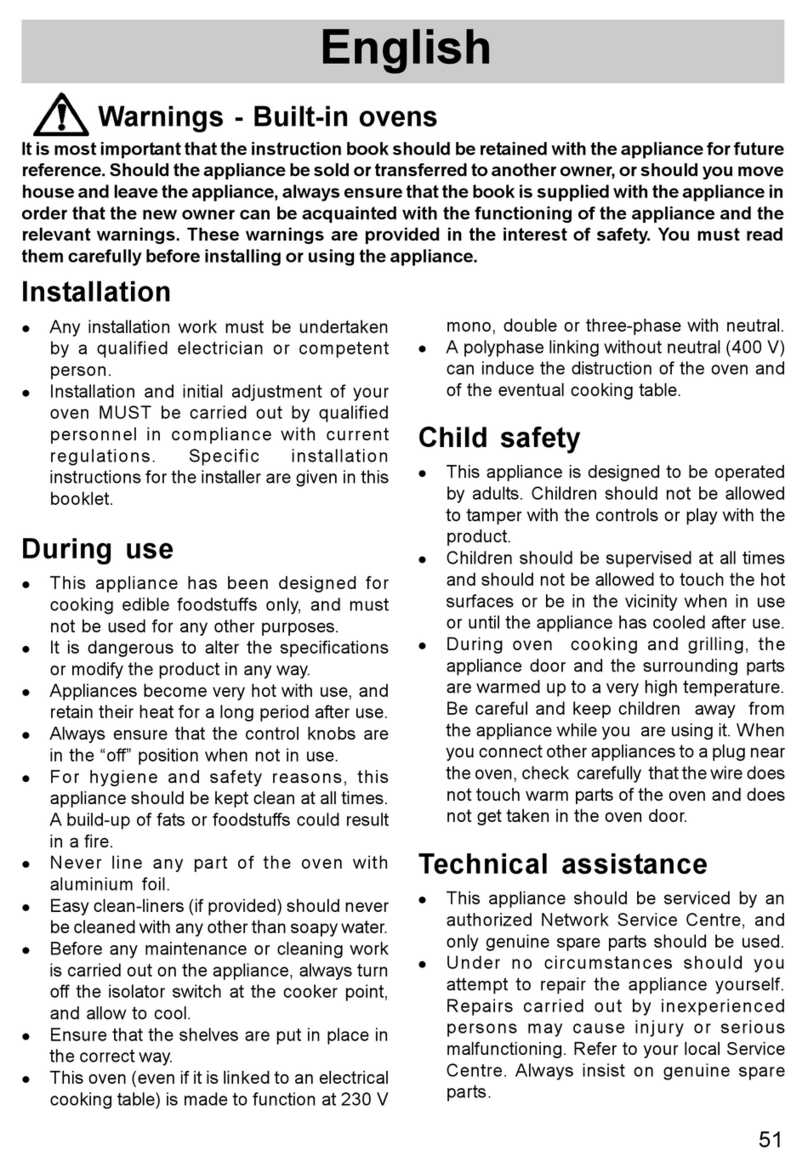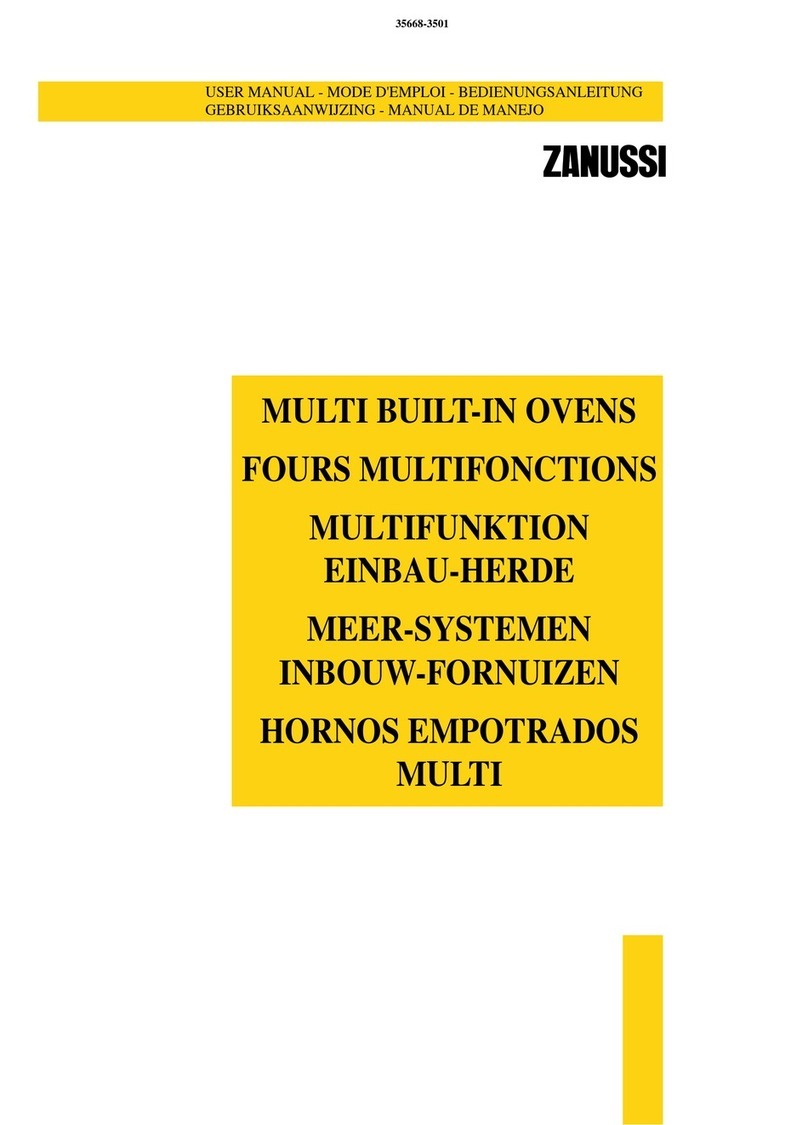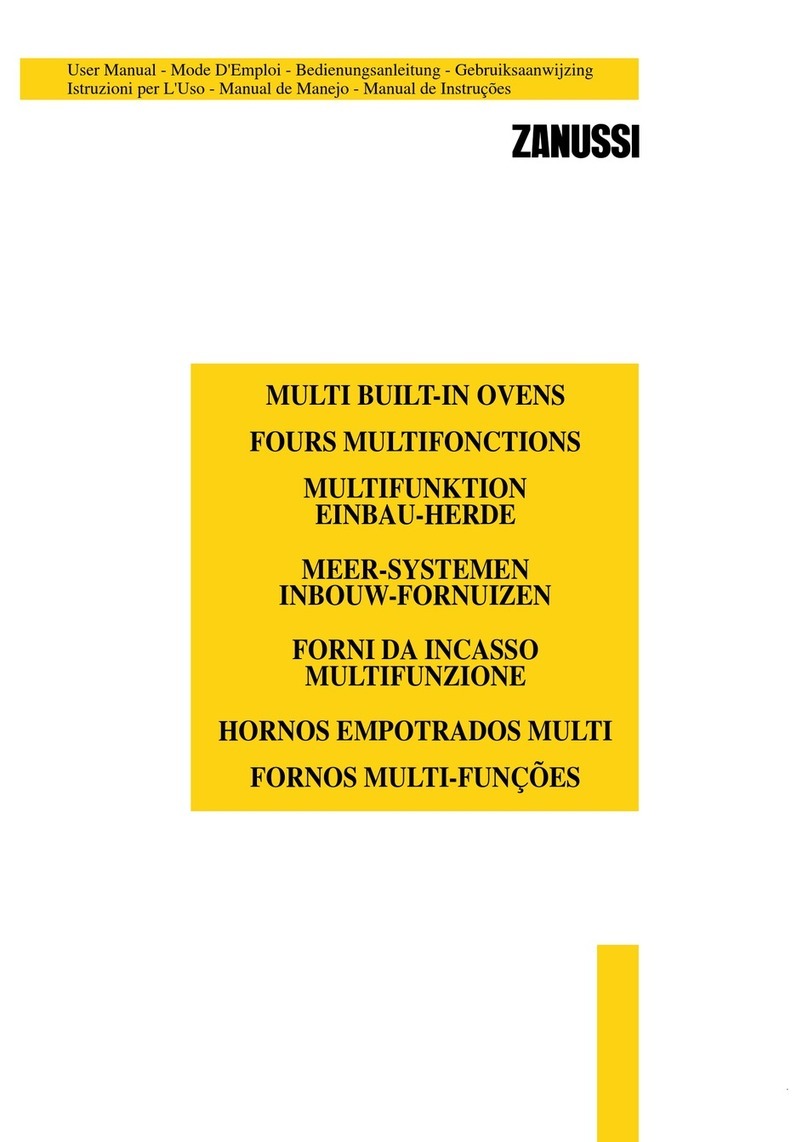GAS CONNECTION
The coo er is fitted with 4 legs for an eventual alignment in height
with the furniture. To assemble them, it is necessary to raise the
coo er and to screw the four legs into the suitable threadings
placed on the corners on the bottom of the appliance.
Fig. 12
This appliance must be installed in accordance with the Gas Safety
(Installation and Use) Regulations (current edition) and the I.E.E
Wiring Regulations.
Detailed recommendations are contained in the following British
Standard Codes of Practice - B.S 6172, B.S 5440: Part 2 and B.S.
6891: Current Editions
For appliances installed in the Republic of Ireland please refer to
NSAI- Domestic Gas Installation I.S 813 Current Editions and the
ETCI Rules for Electrical Installations.
IMPORTANT
This coo er is supplied for use on N tur l G s Only and cannot
be used for any other gas without modification.
Conversion for use on LPG and other gases must only be
underta en by a qualified person. For information for use on other
gases contact your local Service Centre.
The coo er must be installed by a qualified person in accordance
with the Gas Safety (Installation and Use) (Amendment) Regulations
(current edition) and the relevant building/I.E.E. Regulations.
Failure to install the appliance correctly could invalidate any
manufacturers warranty and lead to prosecution under the above
quoted regulations.
In the UK, CORGI registered installers are authorised to underta e
the installation and service wor in compliance with the above
regulations.
Provision for Ventil tion
The room containing the coo er should have an air supply in
accordance with BS 5440: Part 2: The room must have an opening
windows or equivalent; some rooms may also require a permanent
vent. If the room has a volume between 5 and 10m 3, it will require
an air vent of 50cm2 effective area unless it has a door which
opens directly to the outside. If the room has a volume of less than
5m3, it will require an air vent of 100cm2 effective area. If there
are other fuel burning appliances in the same room, BS 5440:
Part 2: (current edition) should be consulted to determine air vent
requirements. Ensure that the room containing the coo er is well
ventilated, eep natural ventilation holes or install a mechanical
ventilation device (mechanical coo er hood). Prolonged intensive
use of the appliance may call for additional ventilation, for example
opening of a window, or more effective ventilation, for example
increasing the level of mechanical ventilation where present. This
coo er is not fitted with a device for discharging the products of
combustion. Ensure that the ventilation rules and regulations are
followed. Excess steam from the oven, vents out at the top bac
edge of the coo er, so ma e sure that the walls behind and near
the coo er are resistant to heat, steam and condensation. Your
coo er must stand on a flat surface so that when it is in position
the hob is level. When in position chec that the coo er is level
by using a spirit level and adjust the 2 feet at the rear and the 2
feet at the front if necessary. It is important that the coo er is stable
and level for the overall coo ing performance.
Remember that the quantity of air necessary for combustion must
never be less than 2m3/h for each W of power (see total power
in W on the appliance data plate).
G s S fety (Inst ll tion & Use) Regul tions
It is the law that all gas appliances are installed by competent
persons in accordance with the current edition of the Inst ll tion
& Use Regul tions. It is in your interest and that of safety to
ensure compliance with the law.
In the UK, CORGI registered installers wor to safe standards of
practice. The coo er must also be installed in accordance with the
current edition of BS 6172. Failure to install the coo er correctly
could invalidate the warranty, liability claims and could lead to
prosecution.
G s Connection ( ll inst ll tion nd service work must be
c rried by CORGI registered engineer)
Prior to installation, ensure that the local distribution conditions
(nature of the gas and gas pressure) and the adjustment conditions
are compatible. The adjustment conditions for this appliance are
stated on the rating plate, located on the inside the front appliance
drawer.
This appliance is not designed to be connected to a combustion
products evacuation device. Particular attention should be given
to the relevant requirements regarding ventilation.
Connection to the coo er should be made with an approved
appliance flexible connection to BS 669. Models for use with LPG
should be fitted with a hose suitable for LPG and capable of
withstanding 50mbar pressure. A length of 0.9 to 1.25m is
recommended. The length of hose chosen should be such that
when the coo er is in situ, the hose does not touch the floor.
The temperature rise of areas at the rear of the coo er that are
li ely to come in contact with the flexible hose do not exceed 700C.
Gas pressure may be chec ed on a semi-rapid hob burner. Remove
the appropriate injector and attach a test nipple. Light the other
burners and observe that the gas pressure complies with the gas
standards in force.
Certain types of coo ers can be connected to the supply both on
the right and left hand side at the rear of the coo er. To reverse
the position, remove the blan ing plug and refit in the side not to
be used. On completion carry out a gas tightness.
ELECTRICAL CONNECTION
OK NO
Fig. 13
INLETSTOP
This ppli nce must be inst lled by qu lified person in
ccord nce with the l test edition of the IEE Regul tions nd
in compli nce with the m nuf cturer instructions.
Ensure that the voltage is the same as that stated on the rating
plate. The rating plate can be found on the bac cover of this
boo .
WARNING! THIS APPLIANCE MUST BE EARTHED
The coo er must be connected to a suitable coo er control unit
incorporating a double pole switch having a contact separation
of at least 3mm in all poles, which is adjacent to (but not above),
and not more than1.25m away from the coo er and easily
accessible. We recommend that the coo er circuit is rated to
20amps.
Cable type H05 RRF 3X 2.5mm2
Connecting the m ins c ble
Open the mains terminal bloc cover as shown over, unscrew the
cableclamp «A» and unscrew (not fully) the screws in the mains
terminal
bloc «L N E» which secure the three wires of the mains
cable.Fit the cable and refit the cable clamp «A» .
Allow sufficient cable length for the coo er to be pulled out for
10



















































